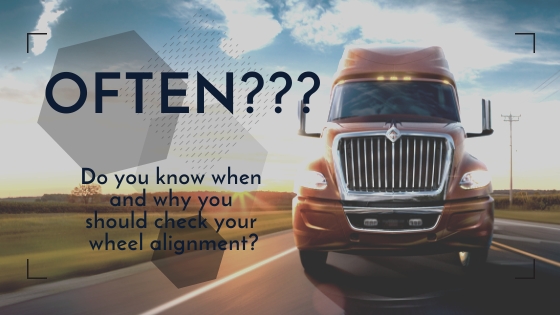How often should wheel alignment be checked?
Wheel alignment is a important aspect of your fleet maintenance plan, the frequently asked question that we have encountered is:
HOW OFTEN?
This all depends on the daily routes, the type of loads and the distances the vehicle takes for trips. There is a lot of factors that gets taken into consideration before making a decision that will best suite your plan. It all depends on the data you have compiled in and around the vehicle to establish the frequency for a wheel alignment schedule to generate the best results for the goal to ultimately save you on costs.
Road safety authorities and testing centres have given much attention to vehicle maintenance and aspects such as tyre safety. Aspects often neglected by vehicle owners are wheel alignment. Most often these aspects are considered irrelevant and little attention is given to their importance. Simple failures that occur at testing centres are because of misalignment as distinguished by a askew steering wheel. Not even aware or considering the importance of the service that impacts the tyre life, and safety on the road and other road users.
One of the first signs would be the steering wheel that will wobble above a certain speed. Mostly wheel alignment is paired with tyre wear and wear patterns. There are even more important reasons why wheel alignment is necessary for safe driving and road safety. These might include the need to reduce strains, stress on the driver and vehicle’s suspension components.
One of many indicators will be your driving behaviour that will help decide how often your vehicle requires wheel alignment. If the tyre tracks of the truck is in a straight even line, you properly don’t need wheel alignment. Even said so; it is still a good idea to have it checked twice a year under normal road conditions. Depending on the distance and road conditions on a daily basis. Rough roads can be your worst nightmare if you’re routine route is a poorly maintained road with bumps, paving comers and pot holes; every hit can affect the vehicle's alignment. In that case-it is recommended to at least check your wheel alignment every 20 000 Km or 4 times a year, whichever occurs first, unless you know that you have collided with a obstacle in the road , like hitting a pothole- in that case it should be re-checked or reset immediate as a precautionary measure.
Wheel alignment is an overall preventative service there is no guaranteed length of time that a vehicle stay aligned after the process due to collisions with curbs, pot holes and overall bad/rough road conditions. If you are experiencing irregular tyre wear, handling problems or a askew steering wheel then wheel alignment should be checked. Ignoring these signs can make your alignment problems more expensive to address over a period. Over looking the signs of when a vehicle is already out of alignment, the wheel alignment should also be checked whenever there are new parts replaced for example: tie rod ends, kingpin, drag links and even bearings (but bearings is only a cause of effect if wheel alignment was performed on worn out bearings). Basically, mostly to do with suspension components and even when new tyres are fitted to prevent tyre wear.
NOTE: The need for a preventative wheel alignment schedule overcomes the extra unnecessary pesky costs compared to a schedule based on your trips and loads!
Or you can follow and like us on




Comments
Post a Comment